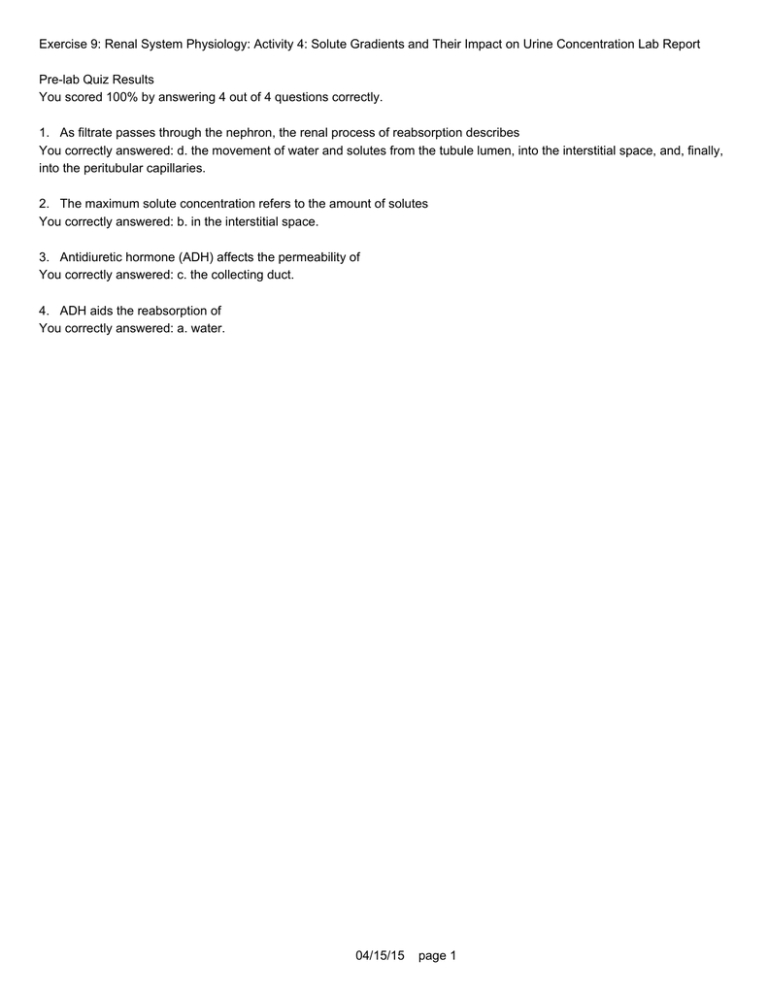Activity 4: Solute Gradients and Their Impact on Urine Concentration
advertisement

Exercise 9: Renal System Physiology: Activity 4: Solute Gradients and Their Impact on Urine Concentration Lab Report Pre-lab Quiz Results You scored 100% by answering 4 out of 4 questions correctly. 1. As filtrate passes through the nephron, the renal process of reabsorption describes You correctly answered: d. the movement of water and solutes from the tubule lumen, into the interstitial space, and, finally, into the peritubular capillaries. 2. The maximum solute concentration refers to the amount of solutes You correctly answered: b. in the interstitial space. 3. Antidiuretic hormone (ADH) affects the permeability of You correctly answered: c. the collecting duct. 4. ADH aids the reabsorption of You correctly answered: a. water. 04/15/15 page 1 Experiment Results Predict Question: Predict Question: What will happen to the urine volume and concentration as the solute gradient in the interstitial space is increased? Your answer : b. The urine volume will decrease and the concentration will increase. Stop & Think Questions: Why is the solute concentration (mOsm) in the proximal tubule the same as in the blood? You correctly answered: d. Because water and many plasma solutes filter into Bowman's capsule. In the presence of ADH, what component of the tubule fluid moves out of the collecting duct and into the interstitial space? You correctly answered: b. water Experiment Data: Urine Volume 80.57 40.28 26.86 16.86 Urine Concentration 300 600 900 1200 04/15/15 Conc. Grad. 300 600 900 1200 page 2 ADH present present present present Post-lab Quiz Results You scored 100% by answering 3 out of 3 questions correctly. 1. Tubule fluid osmolarity will always be the greatest in which of these locations? You correctly answered: b. the bottom of the loop of Henle 2. Tubule fluid volume will always be the greatest in which of these locations? You correctly answered: a. the proximal convoluted tubule 3. Where does ADH directly alter the urine volume? You correctly answered: d. in the collecting duct 04/15/15 page 3 Review Sheet Results 1. What happened to the urine concentration as the solute concentration in the interstitial space was increased? How well did the results compare to your prediction? Your answer: As the solute concentration increased the urine concentration increased proportinally. The urine volume decreased as the solute and urine concentration increased. My prediction was the same. 2. What happened to the volume of urine as the solute concentration in the interstitial space was increased? How well did the results compare to your prediction? Your answer: As the solute concentration increased the urine volume decreased, as my prediction stated. 3. What do you think would happen to urine volume if you did not add ADH to the collecting duct? Your answer: The urine volume would increase if ADH was not added to the collecting duct. This is because the ADH work on the collecting ducts where the increase the permeability for water is increased, so less water is secreted into the urine, so urine becomes more concentrated. 4. Is most of the tubule filtrate reabsorbed into the body or excreted in urine? Explain. Your answer: YHes , most of the filtrates is reabsorbed to maintain homeostasis.The filtrate that enters the proximal tubule is either reabsorbed or secreted. Glucose is reabsorbed mainly in the proximal tubule by GLUT 1 transport carriers. When all these are filled up, then the remaining glucose is secreted in the urine. Both sodium and potassium is filtrated and excessive amount of both is secreted in the urine. Urea is filtered and secreted in the urine. Water is added to the urine, when there is a high concentration in the body, and when there is a change of 1% in osmolality then ADH is added, to maintain the water balance in the body. 5. Can the reabsorption of solutes influence water reabsorption from the tubule fluid? Explain. Your answer: When reabsorption of Nacl occur, then water follows, so other solutes may influence the water reabsorption by making more water follow out of the tubules with the NaCl making the urine concentration increase. 04/15/15 page 4


